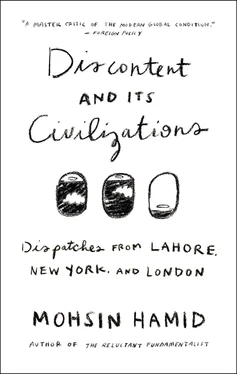Still, it is undeniable that Pakistan has not yet done enough to counter the extremist groups on its soil, whether the Taliban or others. To understand why, it is worth tuning in to the country’s popular prime-time talk shows. There a reflexive blaming of, variously, the US, India, Israel, Afghanistan, Saudi Arabia, or Iran — anybody but Pakistan — for Pakistan’s ills is unfortunately common. The result is a self-image of Pakistan as a pawn in someone else’s game. To turn on one’s TV in Pakistan is to find oneself entering a world permeated with conspiracy theories, an almost mythical space in which a refusal to accept that Pakistan can take the lead in solving its various crises seems not misguided but commonsensical.
The problem, for those who wish Pakistan to take more responsibility for itself, is that these conspiracy theories are not necessarily false. Indeed, many have elements of truth. India likely is striving to exacerbate the violent discontent in Balochistan, Pakistan’s largest province, to the south of the tribal areas. (That discontent is rooted in the Pakistani state’s long-term mistreatment of the province’s local population.) Afghanistan has in fact refused to accept the territorial integrity of Pakistan. Saudi Arabia and Iran do back Sunni and Shia militant proxies in the country. The US has used a vaccination campaign as cover for an intelligence operation on Pakistani soil.
Conspiracy theorists have numerous examples they can cite in support of their positions. But perhaps none is as emotionally potent as the claim that flying robots from an alien power regularly strike down from the skies and kill Pakistani citizens. In the US, such a claim would be science fiction or paranoid survivor cultism of the furthest fringe-dwelling kind. In Pakistan, it is real. And constantly, wrenchingly, in the news.
Among the most pernicious aspects of the US drone campaign in Pakistan is therefore this: that it facilitates the refusal of the Pakistani state and Pakistani society to do more to confront the problem of extremists who threaten Pakistanis and non-Pakistanis alike. Pakistani politicians find it far easier to blame highly unpopular drone strikes for Pakistan’s problems with extremism than to articulate concrete measures against specific extremist groups. President Asif Ali Zardari, whose government has endured heavy criticism for not preventing drone strikes from occurring, has said that “continuing drone attacks on our country, which result in loss of precious lives or property, are counterproductive and difficult to explain by a democratically elected government. It is creating a credibility gap.”
Shahbaz Sharif, a powerful opposition politician, has driven his rhetorical dagger into this gap, claiming that Zardari’s government, despite its denials, is actually helping US drone attacks. The popular cricketer-turned-politician Imran Khan, also lambasting the government for not stopping the drones, has taken an even stronger line. “These strikes have not reduced militancy,” he has said, in views widely echoed by the Pakistani media; “in fact [they] have been a major stimulant to terrorism.”
There was, of course, virulent extremism in Pakistan before US drone attacks began. There would be virulent extremism if US drone attacks ceased. But halting the attacks could quickly accomplish two things: end the obfuscating claim that drones are the cause of terrorism in the country, and make it less difficult for Pakistani politicians to advocate meaningful antiterrorism policies (rather than antidrone policies) without being branded lackeys of an America that regularly violates Pakistan’s sovereignty.
—
WHEN FOREIGNERS intervene militarily in a region with disregard for sophisticated understandings of its internal dynamics, they tend, as recent history has shown, to fail horribly. The prevailing discourse in the West about Afghanistan and Pakistan is “simplistic, inaccurate, and alarmingly dehumanizing,” to quote the editors, Shahzad Bashir and Robert D. Crews, in their introduction to the essay collection Under the Drones . The consequences, they find, have been tragic; and the chapters that follow make it difficult to disagree with them.
An essay by Amin Tarzi, director of Middle East Studies at Marine Corps University, reminds us of the many ways in which leaders in both Afghanistan and Pakistan have used the permeable and uncertain nature of the border between their countries to undermine the state on the other side. The Pakistani security establishment, he writes, has long considered that it is an advantage to have a weak, divided, and pliable Afghanistan. It has been tragically willing to back blood-soaked proxies, such as the Taliban, to that end. Less well known, perhaps, is that, since Pakistani independence, Afghan governments have refused to accept the location of the border. They have continued to maintain claims to Pakistan’s territory west of the Indus — i.e., half of present-day Pakistan — and stoked Pashtun nationalism inside Pakistan by appearing to support the creation of “Pashtunistan,” an independent homeland for Pashtuns.
By intervening militarily in Afghanistan, the US thrust itself into the middle of this border dispute without adequately recognizing it as such. As a result, two successive American presidents have repeatedly failed to get Afghanistan and Pakistan to take joint responsibility for security in the border areas. Tarzi is surely right when he asserts that “a rearrangement of Pakistan — Afghanistan bilateral relations, beginning with resolving the difficult question of the common boundary between the two countries, seems a necessary ingredient” for peace in the region.
One of several other remarkable essays is by James Caron, a lecturer on Islamicate South Asia at the School of Oriental and African Studies in London. He shows, through a historical examination of the expressive arts of the Pashto-speaking region, that the folk figure of the “talib”—or religious student, the singular of “Taliban”—is traditionally seen as romantic, antihierarchical, and opposed to the prevailing culture. There are obvious tensions between this folk figure and the present-day political-military group, but there are unexpected linkages as well. For instance, we read Caron’s surprising description of the young Mullah Omar, now leader of the Taliban, singing classical songs called ghazals on the day he lost an eye during the campaign against the Soviets in the 1980s. One of the lyrics went: “My illness is untreatable, oh, my flower-like friend/My life is difficult without you, my flower-like friend.” Caron suggests that such language allowed Taliban leaders to express their own “pious heroism” in terms familiar from courtly love poetry, and to construct a talib persona of “authoritative respectability” around their themes of “sincerity, earnestness, and morality.”
Also arresting is a folk story, elaborated upon by Caron, of a young man named Talib Jan and Pashtana (literally: “female Pashtun”). In a recently printed version of this story, the two fall in love, but while the poor, low-born Talib Jan is away, Pashtana is persuaded by her unscrupulous family to marry her rich, high-born (“khan”) cousin in London. Talib Jan dies of sorrow — pure, devoted to his love for Pashtana, and penniless — but after his death he comes to be venerated as a martyr. The story seems intended, Caron writes, “to convey… what is, for the author, the heartbreaking rejection of sincere talib morality by Karzai-era Afghan Pashtuns, and their ‘marriage’ to khan-ism through the intervention of foreign brothers.”
The anti-imperialist and antihierarchical echoes of this tale are clear, and quite different from accounts of nihilistic militants belonging to a death cult at war with freedom — or, for that matter, of Pashtun supremacists bent on subjugating other ethnicities. Many of the Taliban have certainly proved themselves murderous, vicious, and Pashtuncentric. But their self-perceptions and the ways their motives are embedded in Pashtun culture do not necessarily correspond to popular caricatures in the West.
Читать дальше












